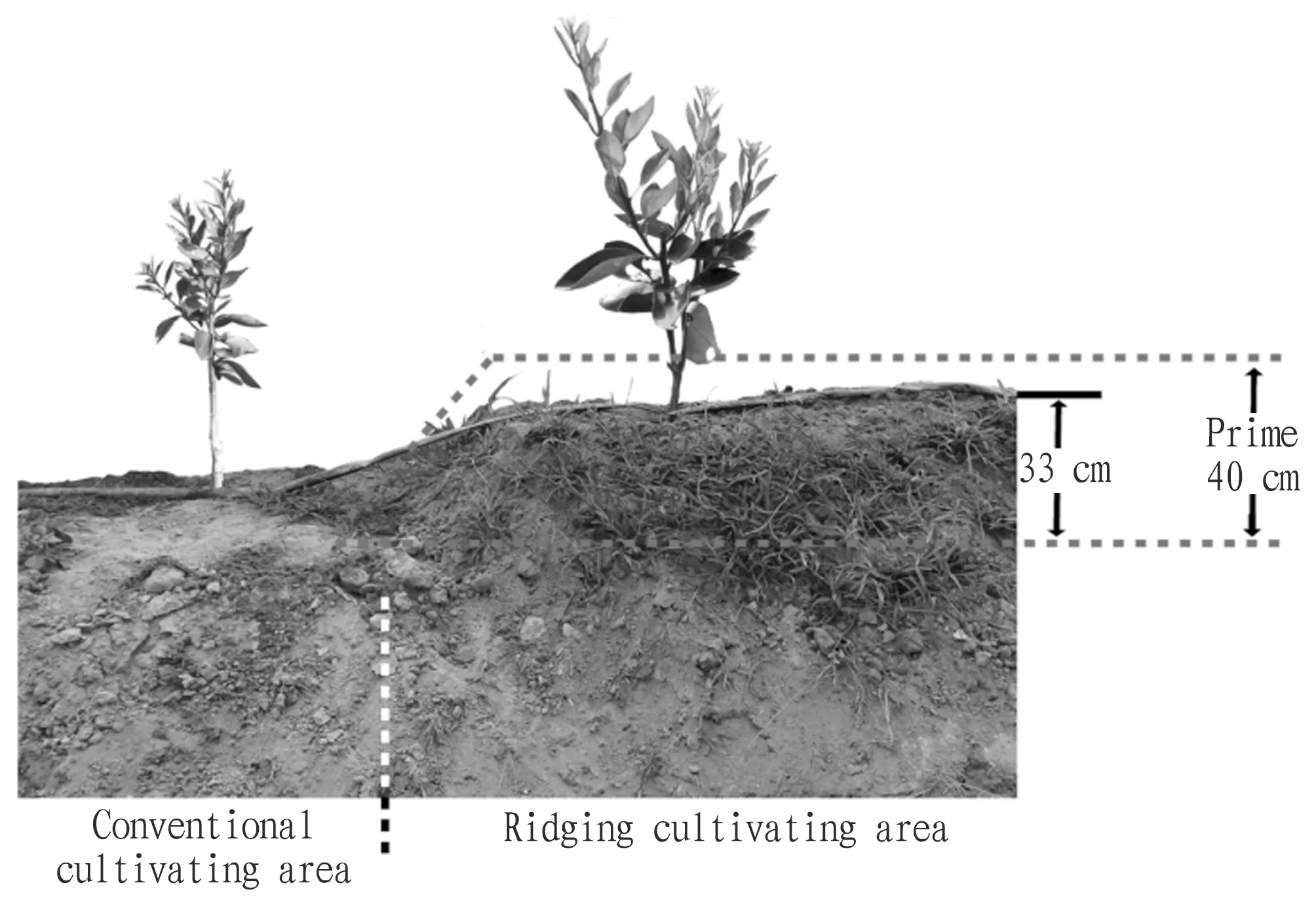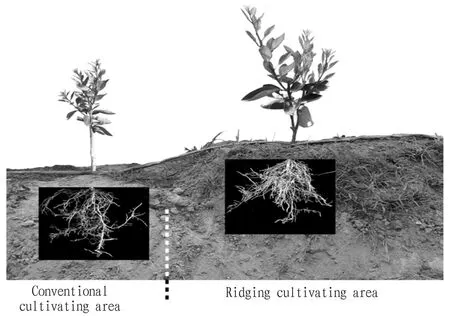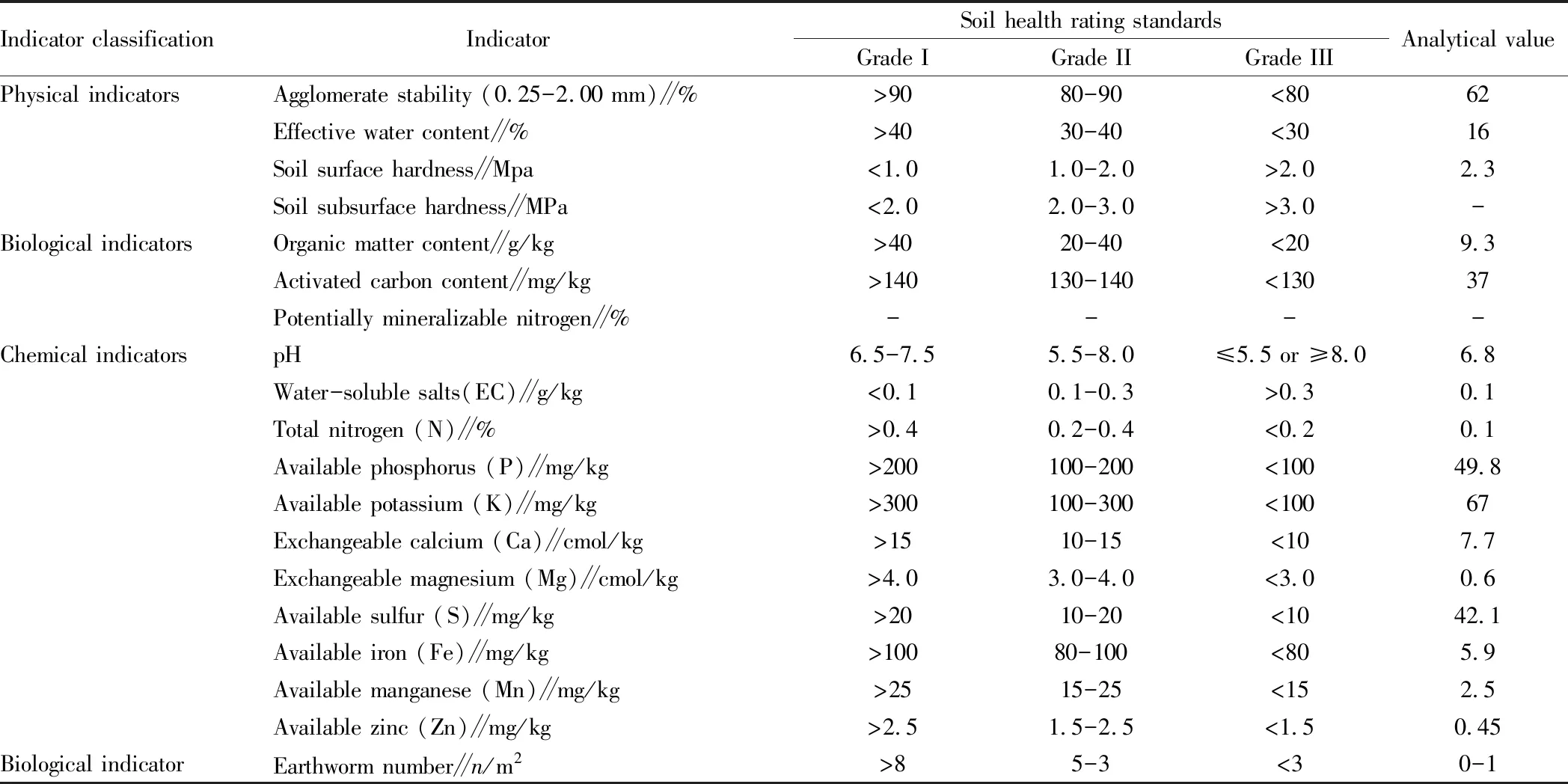Key Points of Ridge Cultivation of Lane Late Navel Orange
2019-06-27,3*,4
,3*,4
1. Yunnan Yuntianhua Co., Ltd., Kunming 650228, China; 2. Yunnan Hengguan Taida Agricultural Development Co., Ltd., Kunming 651700, China; 3. Yunnan Agricultural University, Kunming 650201, China; 4. Yunnan Chemical Research Institute, Kunming 650228, China
Abstract Ridge cultivation can effectively enhance soil permeability, promote root development and improve fruit quality. Based on the characteristics of Lane Late navel orange, this paper summarizes the technical points related to ridge cultivation and compares the effects of ridge cultivation and conventional cultivation on the growth, so as to provide guidance for better production practices.
Key words Lane Late navel orange, Ridge cultivation, Conventional cultivation
1 Introduction
In recent years, some newly-planted citrus orchards have adopted a ridge cultivation, realizing field planting in the first year, fruit bearing from the third year, and higher leaf dry matter content and fruit quality than the conventional cultivation[1-2]. Ridging is not only conducive to improving the drainage and flood control capacity of orchard soil but also capable of alleviating soil stickiness, tree yellowing, root death and other problems caused by uneven water distribution after rain[2-6]. Lane Late navel orange is a late-maturing variety, which is listed from March to April every year. During August-September, 2018, Lane Late navel orange was planted next to the Longjiang Reservoir in Mengyue Township, Longchuan under the mode of ridge cultivation. After a certain time, it was found that the growth rate of the late autumn shoots and spring shoots was better than that under the conventional cultivation mode. The relevant technical measures are summarized as follows in order to provide reference for the growers of navel orange fruit trees.
2 Effects of ridge cultivation on the biological characteristics of Lane Late navel orange
2.1 Field observation of ridge cultivation and conventional cultivationCompared with conventional cultivation, ridge cultivation showed early sprouting, more new leaves and better leaf gloss (Fig.1).
2.2 Investigation on lateral root number, fibrous root number and new leavesThe roots of the Lane Late navel orange plants were thoroughly washed, and then the growth of the roots was observed (Fig.2). After the roots were sorted, they were scanned with a computer image analyzer (WinRHIZO, Regent Ins Inc, Canada), and the lateral root number and fibrous root number were analyzed by software. As shown in Table 1, ridge cultivation had a positive effect on the early growth of Lane Late navel orange, and the main performance was to increase the number of lateral roots, the number of fibrous roots and the number of new leaves. After half a year, compared with conventional cultivation, the lateral root number, fibrous root number and new leaf number under ridge cultivation mode were increased by 18.2%, 21.3% and 32.1%, respectively. From the perspective of the early growth, ridge cultivation was beneficial to the growth and development of Lane Late navel orange, and the synergistic growth of the underground and above ground parts showed a positive effect on the formation of crowns, early and high yield, and fruit quality. However, under the ridge cultivation mode, the soil was exposed to the air, and its water retention capacity was weaker than flat cultivation. Therefore, in the later management process, it is necessary to strengthen the frequency of watering or increase the soil water retention capacity by means of film mulching. At the same time, the growth of weeds must be controlled effectively.

Fig.1 Comparison between ridge cultivation and conventional cultivation

Fig.2 Comparison of root system of Lane Late navel orange between ridge cultivation and conventional cultivation
Table 1 Comparative analysis between conventional cultivation and ridge cultivation(n=10)

Cultivation modeLater rootnumberFibrous rootnumberNewly-sproutedleaf numberRidge cultivation5.2±1.1 a536.6±73.6 a70.0±4.0 a Conventional cultivation4.4±1.0 b442.3±54.8 b53.0±2.8 b
Note: Different lowercase letters in the same column indicate a significant difference at the 0.05 level.
3 Pre-treatment before ridge cultivation
The small-area ecological environment enclosed by shelter forests is conducive to reducing the occurrence and spread of pests and diseases and improving the yield and quality of crops[7-9]. In this study, the perennial grassPennisetumsineseRoxb was used as a shelter forest. In previous period, some of the plots in the orchard were planted with sugarcane, and the others were distributed with weeds, so that the active soil layer was thin (4-8 cm), and the quality of the soil was poor. In this study, large-scale agricultural machinery was used for plough and land preparation. During the rotation of the coulter, the upper layer of 10-15 cm of the soil and weeds were chopped and mixed, playing the role of loosening, breaking and flatting soil. Then, the land was exposed to sunlight for 10-15 d. After deep ploughing and exposure to sunlight, many harmful bacteria in the soil were killed, and the permeability of the soil was improved, which greatly reduced the occurrence of soil-borne diseases and improved the stress resistance of the fruit trees.
4 Ridge cultivation
4.1 Ridging and soil improvementThe surface active soil was mixed with a certain amount of fertilizer using agricultural machinery and then it was ridged at a spacing of 4 m. At the row spacing of 4 m, the land was delimitated. On the surface of the furrows, a little amount of lime was sprinkled to facilitate later fertilization and ridging. Along the planting rows, fertilizer was applied to every area 1 m long and 0.8-1.0 m wide. Along the planting rows, the soil was ploughed two times using a rotary tiller to fully mix the surface soil and fertilizers. Ridging along the planting rows was completed by a ridger. The ridge face had a ladder shape, with upper bottom of 1.0 m, lower bottom of 1.4 m and height of 0.4 m. The health assessment of the plot was carried out referring to the soil healthy assessment system[10]. As shown in Table 2, the soil in the test plot was of Grade D, which was very unsatisfactory. The main manifestations were as follows: (i) the contents of mineral elements were low, and except that of sulfur, the contents of total nitrogen (N), available phosphorus (P), available potassium (K), exchangeable calcium (Ca), exchangeable magnesium (Mg), available iron (Fe), available manganese (Mn) and available zinc (Zn) were far from the standards for Grade III; (ii) the content of organic matter was low (only 9.3 g/kg, the standard for Grade III is 20 g/kg), the aggregate structure of the soil was poor (62%, the standard for Grade III is 80%), the water retention was not ideal (16%, the standard for Grade III is 30%), and almost no earthworm was found in the plot.
Table 2 Soil health rating

Indicator classificationIndicatorSoil health rating standardsGrade IGrade IIGrade IIIAnalytical valuePhysical indicatorsAgglomerate stability (0.25-2.00 mm)∥%>9080-90<8062Effective water content∥%>4030-40<3016Soil surface hardness∥Mpa<1.01.0-2.0>2.02.3Soil subsurface hardness∥MPa<2.02.0-3.0>3.0-Biological indicatorsOrganic matter content∥g/kg>4020-40<209.3Activated carbon content∥mg/kg>140130-140<13037Potentially mineralizable nitrogen∥%----Chemical indicators pH6.5-7.55.5-8.0≤5.5 or ≥8.06.8Water-soluble salts(EC)∥g/kg<0.10.1-0.3>0.30.1Total nitrogen (N)∥%>0.40.2-0.4<0.20.1Available phosphorus (P)∥mg/kg>200100-200<10049.8Available potassium (K)∥mg/kg>300100-300<10067Exchangeable calcium (Ca)∥cmol/kg>1510-15<107.7Exchangeable magnesium (Mg)∥cmol/kg>4.03.0-4.0<3.00.6Available sulfur (S)∥mg/kg>2010-20<1042.1Available iron (Fe)∥mg/kg>10080-100<805.9Available manganese (Mn)∥mg/kg>2515-25<152.5Available zinc (Zn)∥mg/kg>2.51.5-2.5<1.50.45Biological indicatorEarthworm number∥n/m2>85-3<30-1
In combination with the soil conditions and the fertilization requirements of Lane Late navel orange, 20 kg of mineral source organic fertilizer, 15 kg of farmyard mature, 0.05 kg of compound fertilizer (15-15-15) and 0.05 kg of Digengxin (13-33-4) were applied to every fertilization area.
The mineral source organic fertilizer, prepared by activation of lignite, contained abundant mineral source humic acid, which could form organic and inorganic complexes with many nutrients in the soil, increasing the effective supply of soil nutrients and strengthening the soil agglomeration mechanism. In addition, mineral source organic fertilizer also contained calcium, magnesium, zinc, iron, molybdenum, silicon and other nutrients and beneficial elements to effective improve soil deficiency.
The farmyard mature was produced by fermenting manure (cate and sheep manure) and bagasse,etc. according to a certain proportion. It was rich in organic matter, and also contained active components such as humid acid, amino acids, cellulose, lignin, nucleic acids, peptides and proteases needed by crop growth and soil fertility.
The synergy between mineral source organic fertilizer, farmyard manure, compound fertilizer and Digengxin (containing amino acids, oligosaccharides and other biostimulating factors[11-12]) could effectively improve the soil in the test plot and enhance the immunity and stress resistance of the fruit trees.
4.2 Field planting(i) The Lane Late navel orange seedlings were first cut short to 35-50 cm, and the grafting film was removed. The leaves of some seedlings were halved to reduce the evaporation of water during the field planting. The seedlings should be watered regularly before the field planting. (ii) The growers were divided into pairs. In each group, one person excavated the planting holes at a distance of 2 m along the middle line of each ridge and cleared stones and debris in and round the planting holes; and the other put the Lane Late navel orange seedlings into the center of the planting holes (the grafting interface was 7-15 cm higher than the ridge surface), covered soil to about 1/3 of the root system, compacted the soil around the root system, lift the seedlings up, and finally earthed up the seedlings while compacting. (iii) Sufficient water was poured to the roots of each fruit tree (8-12 kg/plant) on the same day of field planting. On the 3rd and 5th days, 5-10 kg of water was supplemented to each fruit tree. After watering, soil was covered in time to avoid exposure of the roots.
5 Maintenance management after planting
5.1 Fertilizer and water managementAfter 5-10 d of field planning, the foliage was sprayed with amino acids or fulvic acid to induce a sustained systematic immune responses in plants and reduce plant stomatal opening, thereby achieving effects of inhibiting plant transpiration, reducing the amount of water evaporation of the young trees, enhancing plant immunity and increasing planting survival rate[13-14]. This study found that the water retention capacity of ridge cultivation was not as good as that of flat cultivation. Compared to flat cultivation, the frequency of watering in ridge cultivation needed to be increased. If possible, the ridge surface can be covered with a reflective film with good water permeability to increase the illumination of the middle and lower layers of young trees, reduce the growth of pests and weeds and lay a foundation for the healthy growth of young trees, while effectively reducing the evaporation of soil moisture. When sprouting begins, nitrogen fertilizer can be applied in time to enlarge the crown of young trees. During the growth of spring shoots, autumn shoots and winter shoots, nitrogen fertilizer (e.g. urea) can be applied less but more times to make the sprouting shoots uniform and strong and the leaves thick and green, thereby forming high-yield canopies early.
5.2 Disease and pest controlIn order to prevent leaf miners, mites (red spider,etc.) and various fungal and bacterial diseases from harming newly-sprouted shoots, when new shoots grow to 2-5 cm long, they can be sprayed with chlorothalonil or carbendazim plus avermectin or diafenthiuron, imidacloprid or the like.
杂志排行
Asian Agricultural Research的其它文章
- Delimitation and Zoning of Natural Ecological Spatial Boundary Based on GIS
- Career Planning Education Paths for Students of Aquatic Animal Medicine Discipline in the Context of the Belt and Road Initiative: A Case Study of Construction Achievement of Guangdong Ocean University
- Pilot-scale Study on NCMBR Process for Upgrading of Sewage Treatment Plant in Industrial Park
- Preliminary Exploration on Design of Green Landscape of Urban Streets: A Case Study of Guangchang East Road in Xihu District of Nanchang City
- Present Situation and Renovation Strategies of Farmhouses in Yingxi Village, Fuliang County, Jingdezhen
- Influence of Sino-US Agricultural Trade on China’s Total Agricultural Output Value Based on Cointegration Model
